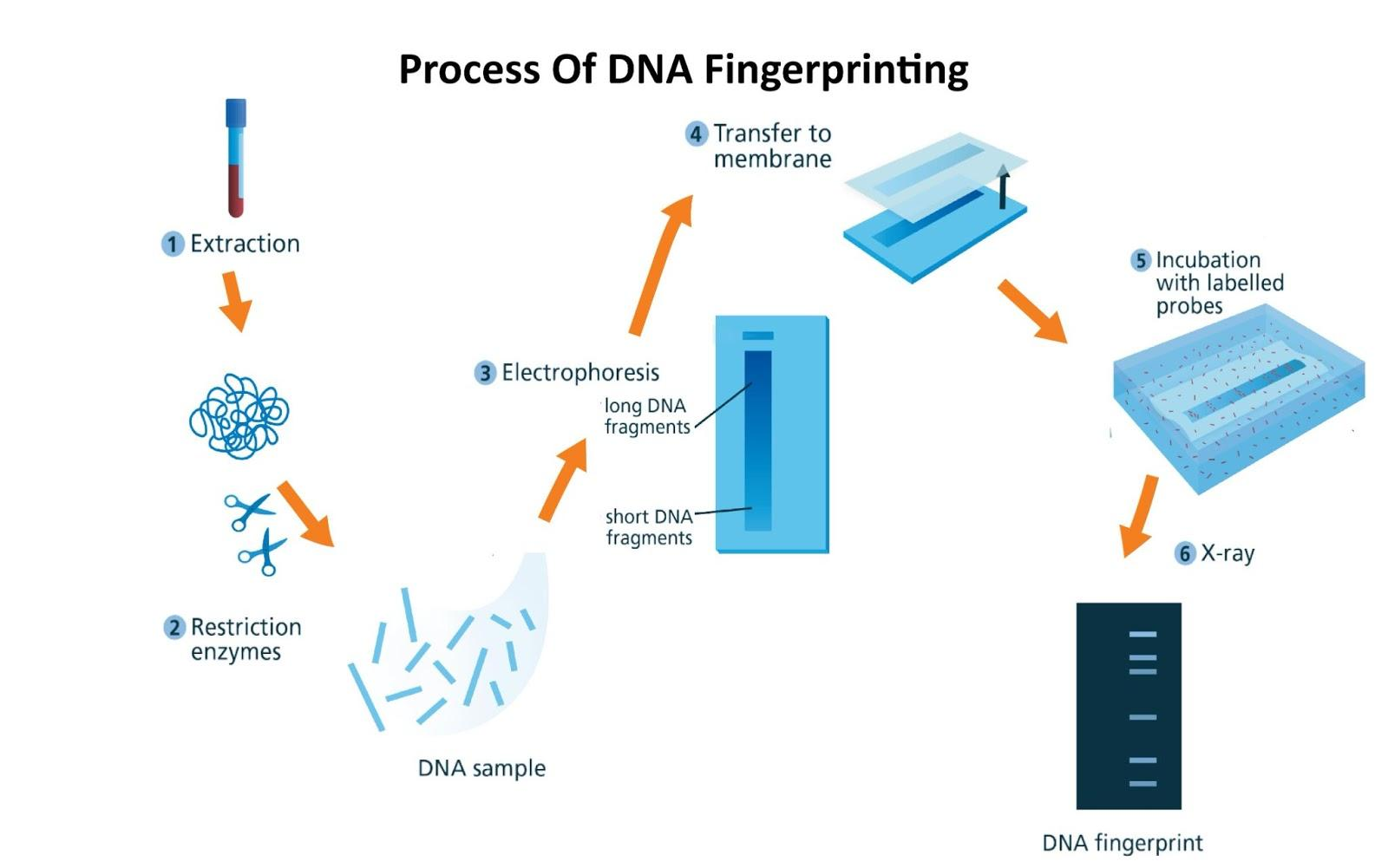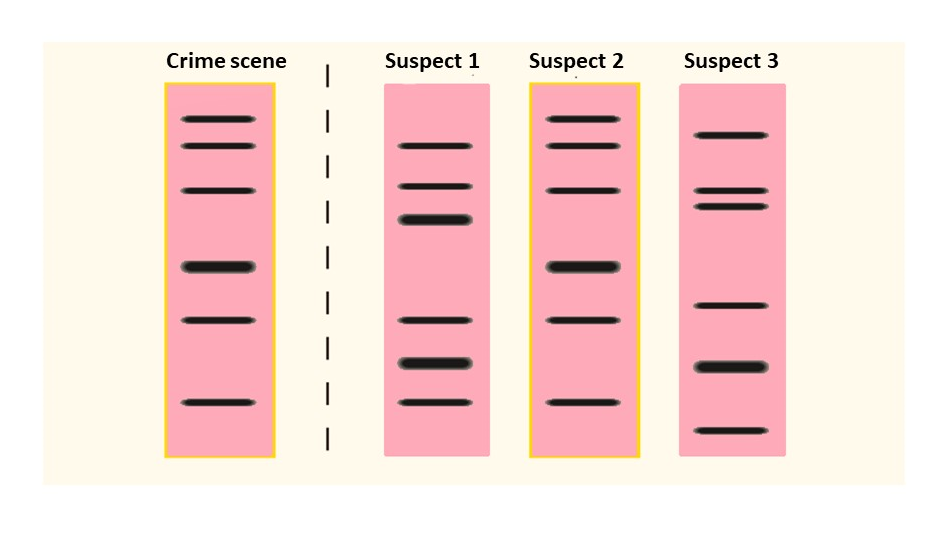What is the DNA Fingerprinting Process?
DNA fingerprinting is a powerful technique used to distinguish between individuals by analysing specific regions of their DNA. Unlike the coding regions that carry genetic information for protein synthesis, these unique patterns arise primarily from non-coding, repetitive segments (also known as satellite DNA). Because these segments vary greatly between individuals (polymorphism), DNA fingerprinting has revolutionised fields such as forensic science, paternity testing, and evolutionary biology.
Overview
DNA fingerprinting (also called DNA profiling) is a laboratory procedure that identifies the unique genetic makeup of an individual. The process focuses on variable number tandem repeats (VNTRs) or other polymorphic regions in the genome, particularly in the non-coding parts of DNA. Although these regions do not code for proteins, they exhibit a high degree of variation from one person to another.
Read More: DNA Replication
Some key points to understand:
Non-coding DNA: A major portion of the human genome does not directly code for proteins. These regions often have repetitive sequences.
VNTRs and STRs: Variable Number Tandem Repeats (VNTRs) and Short Tandem Repeats (STRs) are examples of repeated sequences that differ among individuals.
Polymorphism: Because the length and number of repeats vary widely between people, these regions form the basis of DNA fingerprinting.
Also Read: DNA Structure
Steps of DNA Fingerprinting (DNA Fingerprinting Steps)
DNA Isolation
Scientists collect a sample (e.g., from blood, hair follicles, saliva).
The cells are broken open, and DNA is carefully extracted and purified.
Digestion with Restriction Enzymes
Special proteins known as restriction endonucleases are used to cut the DNA at specific sequences.
This creates fragments of varying lengths based on each individual’s unique repeat patterns.
Separation by Electrophoresis
The DNA fragments are placed in a gel and subjected to an electric field.
Smaller fragments move faster through the gel, thus separating DNA fragments according to size.
Blotting onto a Membrane
The separated fragments from the gel are transferred (blotted) onto a nylon or nitrocellulose membrane.
This makes the DNA stable and accessible for further analysis.
Hybridisation with Labelled Probes
Specific VNTR or STR probes, often radioactively or fluorescently labelled, bind to complementary sequences on the DNA fragments.
These probes highlight the areas of interest that display polymorphism.
Autoradiography (or Imaging)
An X-ray film or other imaging technique is used to detect the labelled probes.
The result is a series of distinct bands unique to each individual, known as the DNA fingerprint.
Below is a simplified representation of a DNA fingerprinting diagram illustrating this process:

[Sample Collection] → [DNA Extraction] → [Digestion by Restriction Enzymes]
↓ ↓
[Gel Electrophoresis] → [Transfer to Membrane] → [Probe Hybridisation] → [Imaging/Autoradiography]

Application of DNA Fingerprinting
The application of DNA fingerprinting is extensive, owing to the technique’s ability to distinguish individuals with remarkable precision. Some of the most notable uses include:
Forensic Investigations
Any DNA sample found at a crime scene (hair, blood, saliva) is profiled.
Suspects’ DNA can be compared against the crime scene profile to identify or eliminate individuals.
Paternity and Maternity Testing
DNA fingerprinting can confirm biological relationships with high accuracy.
This is particularly useful when determining the parents of an unclaimed infant or resolving family disputes.
Population Genetics and Evolutionary Studies
Researchers track the frequency of specific alleles (gene variants) in a population.
Changes in these frequencies (genetic drift or natural selection) can provide insights into evolutionary trends.
Conservation Biology
Monitoring genetic diversity in endangered species to plant breeding programmes.
Ensuring that inbreeding is minimised by accurately identifying lineage.
Medical Diagnostics and Transplant Matching
Though more commonly associated with HLA (human leukocyte antigen) typing, DNA fingerprinting can contribute to matching donors and recipients.
Helps reduce the risk of organ rejection and complications.
Additional Insights and Unique Content
To offer an even deeper perspective beyond the basics:
Historical Context
Sir Alec Jeffreys, a geneticist at the University of Leicester, pioneered modern DNA fingerprinting in 1984.
The technique gained worldwide recognition after it was successfully used to solve a high-profile criminal case in the UK.
Modern Variations
PCR-based STR Analysis: A more rapid method that amplifies specific repetitive regions using Polymerase Chain Reaction. This approach is extremely common in forensic labs today.
Next-Generation Sequencing (NGS): The advent of NGS technology enables faster, more comprehensive profiling for research and personalised medicine.
Ethical Considerations
The use of genetic data raises important privacy and consent issues.
Safeguarding personal genetic information is crucial to prevent misuse or discrimination.
Limitations
Quality of the Sample: Degraded or contaminated DNA can lead to inconclusive results.
Cost and Resources: Although more affordable than before, advanced DNA fingerprinting can still be expensive and requires specialised equipment.
Future Prospects
As technologies advance, DNA fingerprinting may integrate with broader genomic databases.
Potential for more accurate and rapid testing in both clinical and forensic settings.
Related Links: Difference Between DNA and RNA


FAQs on DNA Fingerprinting: Definition, Steps, and Applications
1. How does DNA fingerprinting differ from DNA sequencing?
DNA fingerprinting compares specific repetitive segments within the genome to differentiate individuals, whereas DNA sequencing determines the exact nucleotide order across a region or the entire genome.
2. Can DNA fingerprinting be performed on degraded samples?
Yes, but highly degraded samples might not yield clear band patterns. Techniques like PCR-based analysis can sometimes amplify even small fragments of DNA, improving success rates.
3. Is DNA fingerprinting 100% accurate?
DNA fingerprinting is exceptionally accurate when performed correctly. Errors typically stem from sample mishandling, contamination, or human mistakes in the lab.
4. What role does DNA fingerprinting play in organ transplants?
Although HLA typing is the gold standard, DNA fingerprinting can provide an additional layer of genetic matching between donors and recipients, minimising transplant rejection risks.
5. How has DNA fingerprinting advanced over the years?
Initially reliant on longer VNTR fragments, modern methods often use STRs amplified by PCR, enabling faster, more sensitive, and more reliable results even from minimal samples.
13. What are the applications of DNA fingerprinting in research?
The application of DNA fingerprinting extends to research fields like evolutionary biology, where it helps track genetic diversity and analyse genetic drift. It is also used in medical genetics for detecting hereditary disorders.










